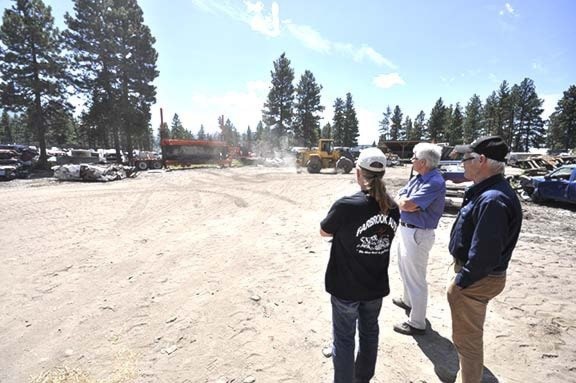Farbrook Auto Wrecking is one of the only salvage yards in the area, and with the recent closure of Hosmer's wrecker, vehicles have been piling up faster than before.
To get their car stock into a manageable size, Farbrook has brought in a car crusher, which for the next two months or so will crush its way through the towering piles of discarded and destroyed cars.
On Thursday afternoon, Farbrook's owner Chris Taylor took Mayor Wayne Stetski for a tour of the facility. Taylor hopes to build a processing building on the lot sometime in the future, as a way to increase efficiency and safety, but faces some zoning issues, as the property is zoned as residential.
Taylor was touring Mayor Stetski around to show the mayor the types of things they do at the wrecker and how things work.
Taylor said the wrecker takes in about 1,000 cars a year and holds between 1,000 and 1,200 cars in the lot, not including the ones piled up and set to be crushed. The crusher is brought in by a company outside of town.
"It has enough force to crush engine blocks," Taylor said as the group stood in front of the crusher, as a giant forklift piled another car on the crushed remains of an old station wagon.
Taylor explained that about 75 per cent of the wreckers business comes from taking in cars and selling for parts, including ICBC claims vehicles. The other 25 per cent comes from the recycling aspect of it.
The lot is also used by the fire department and search and rescue to practice auto-extraction techniques and train new recruits.
A number of years ago Taylor tried to pursue the processing building but ran up against the city's zoning bylaw. The wrecker can continue to operate, but can't expand. But Taylor noted it's not an expansion he is pushing for, it is an upgrade so that conditions and safety can be improved.
"The building is to bring them in and process them; to drain them," he said. "It would be to work on them. It's hard to drive around in a yard truck, with tools, and pull a motor in the yard."
Stetski said the challenge is the zoning, which would require a change or a variance permit. He said that being on the yard, it's not hard to see why a building would be nice.
"From a lot of perspectives, having a building makes sense," Stetski said.
Taylor is currently working with the Ministry of Environment on the proposal, which will have to approve it before it goes in front of council.
"We can exist, but we can't grow (in area)," Taylor said, adding that he intends to make the existing business better as well as improving environmental standards.
